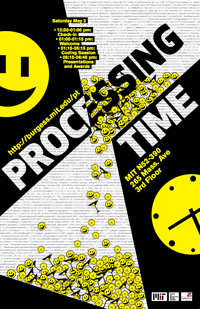Processing Time
 Spend your Saturday making clocks with code:
Spend your Saturday making clocks with code:
Processing Time
A code jam / party and programming competition
Part of the Boston Cyberarts FestivalSaturday, May 2, 2009 – MIT N52–390
265 Massachusetts Ave, 3rd Floor
Concept
- Compete individually or in pairs to design and develop beautiful programs in Processing
- Snack and refresh yourself
- Present completed projects to other participants and visitors at the end of the day
- Anyone (not just MIT students or community members) can compete, anyone can stop by to see presentations
- Meet the creators of Processing, Ben Fry (in person) and Casey Reas (via video), who will award prizes
Schedule
- 12:30-01:00 pm: Check in
- 01:00-01:15 pm: Welcome
- 01:15-05:15 pm: Coding Session
- 05:15-06:45 pm: Presentations and Awards – Public welcome!
Registration
Register in advance, individually or in two-person teams, by emailing processing-time@mit.edu with one or two participant names and a team name.
Festival
Processing Time is sponsored by MIT (Arts Initiatives at MIT, Center for Advanced Visual Studies, Program in Writing & Humanistic Studies) and is part of the Boston Cyberarts Festival.
The Processing Time page, linked to a nifty poster, is at: burgess.mit.edu/pt

